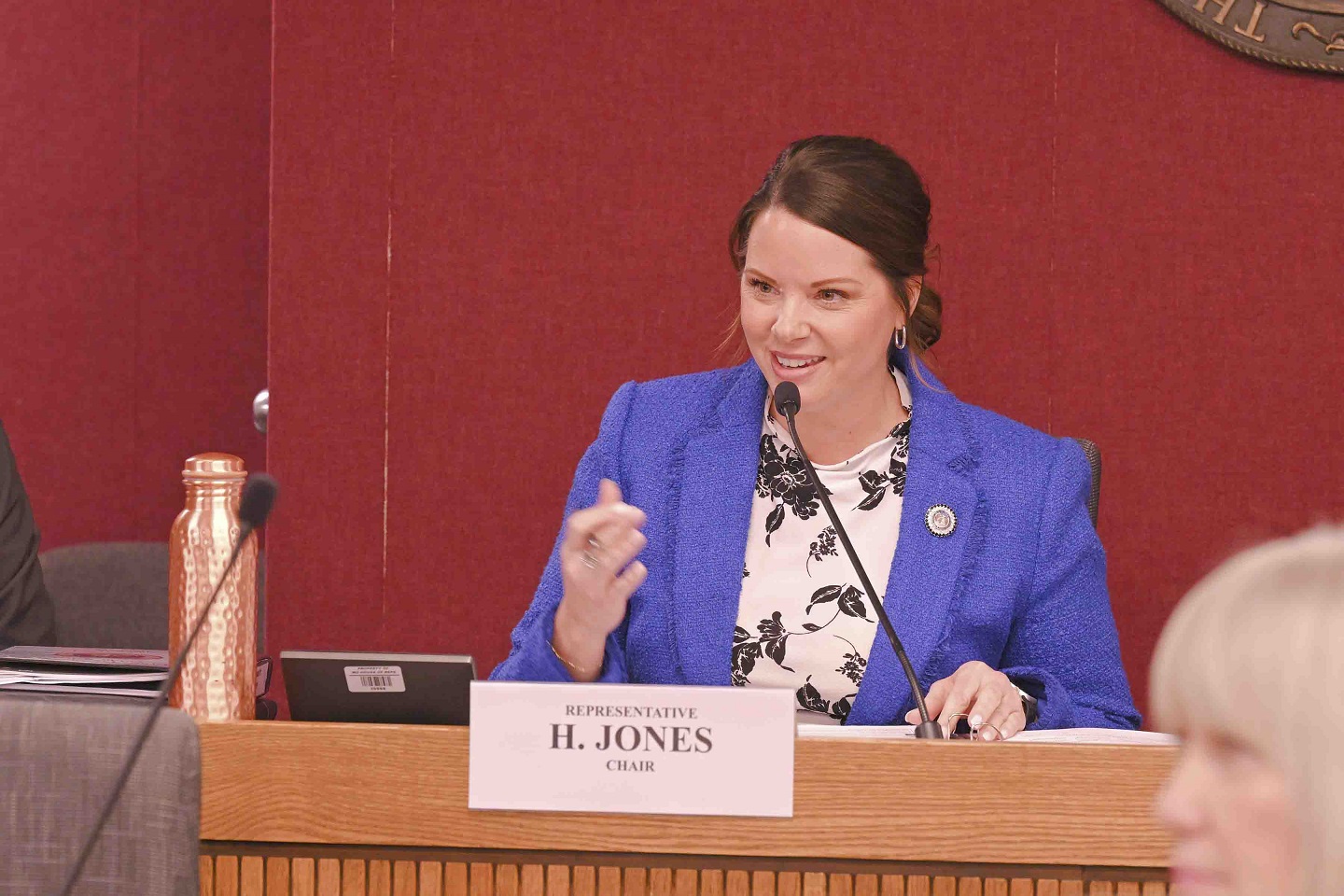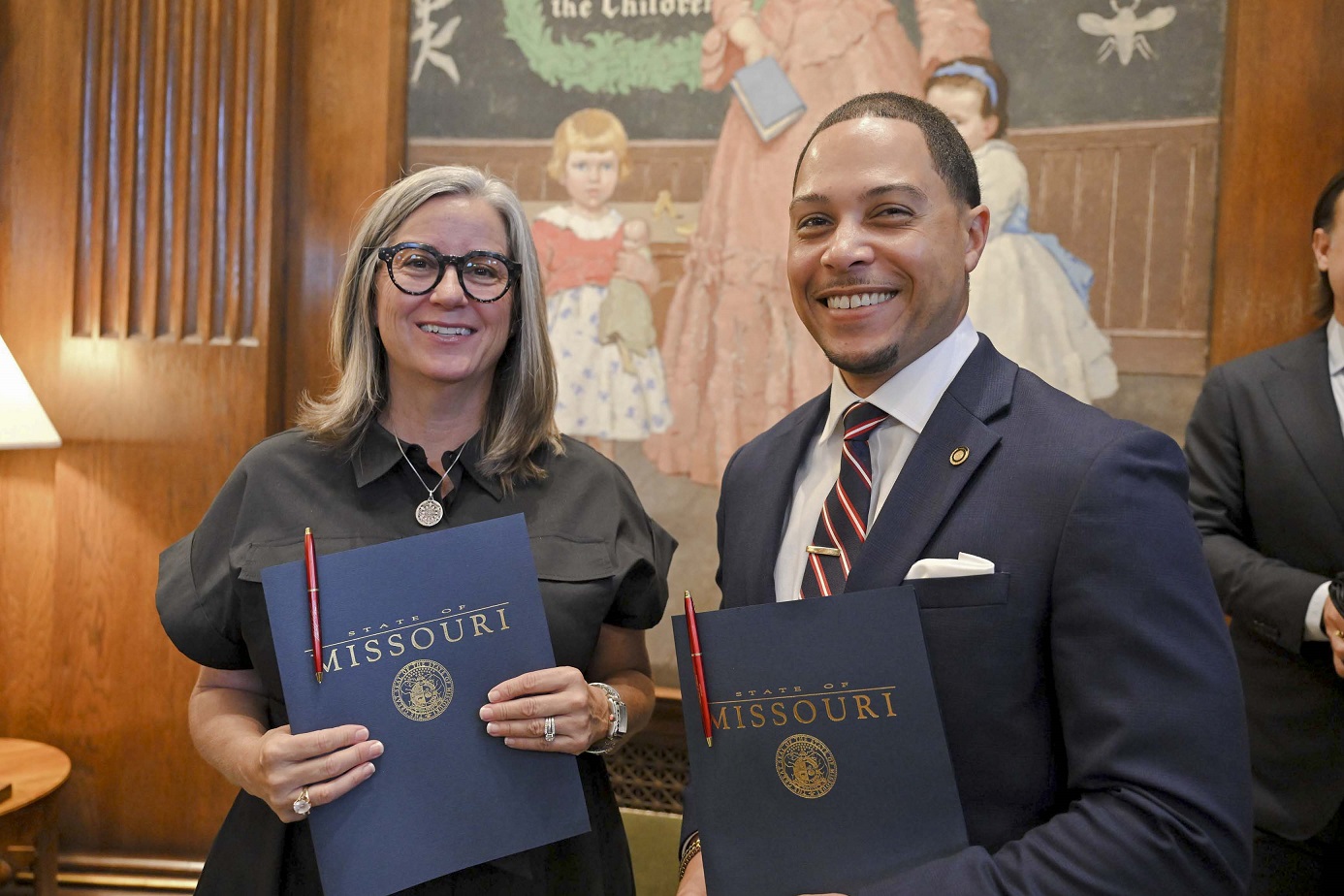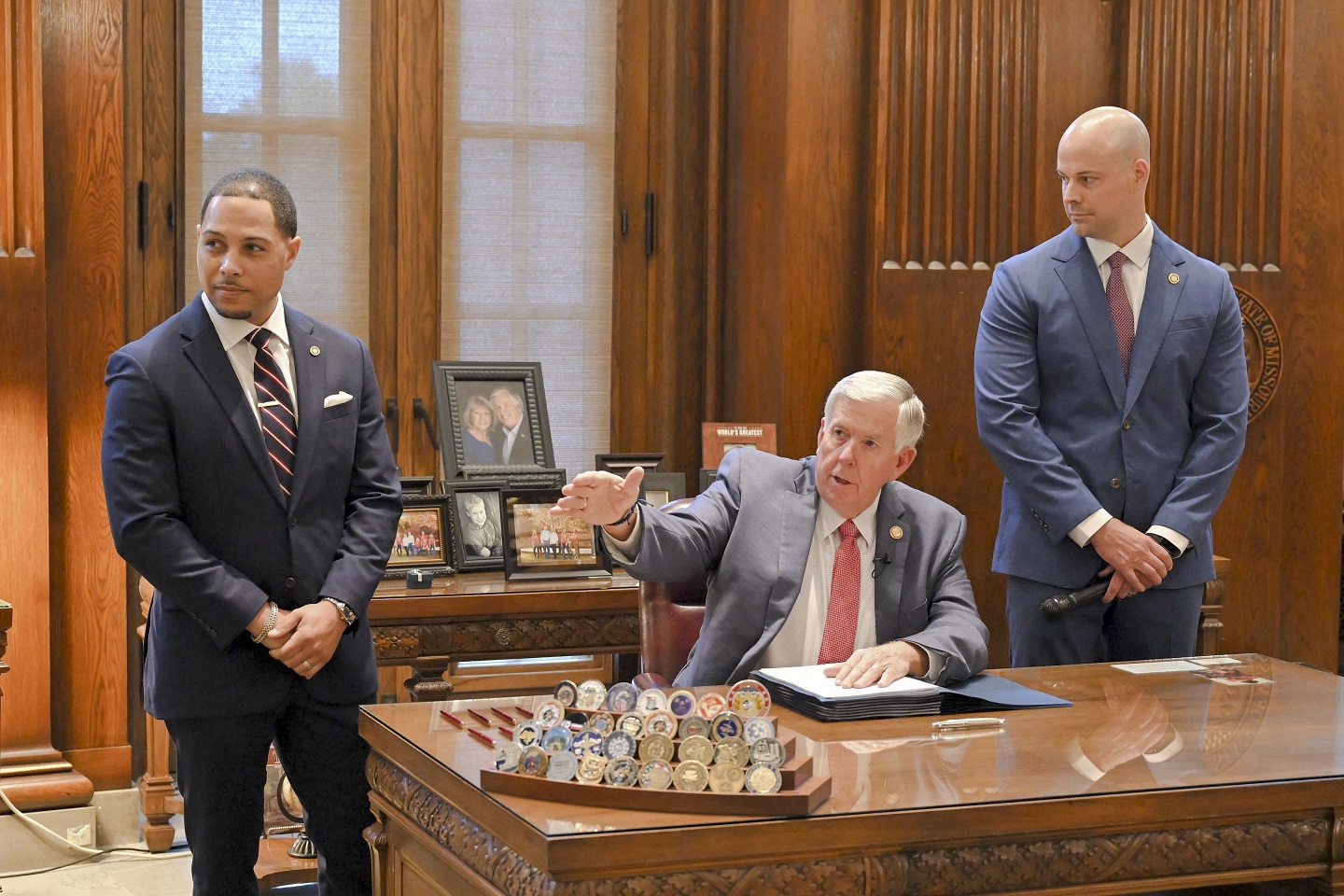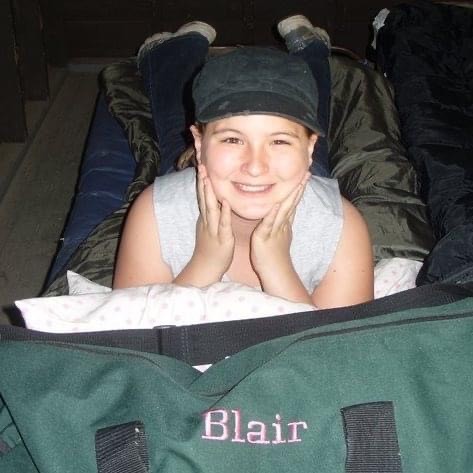In his daily prayer at the opening of the session, Missouri House Chaplain Msgr. Robert A. Kurwicki today delivered a prayer that reflected the hopes of the chamber’s Kansas City Chiefs fans, ahead of their attempt to win a third straight championship.
Author: Mike Lear
VIDEO: Reps Address Bills on Transgender Issues, Announce Equality Conference
Missouri House Democrats spoke to reporters ahead of a committee hearing in which eight bills dealing with transgender issues will be presented, and announce they have formed the Equality Conference.
VIDEO: House Democrat response to State of the State Address
Missouri House Democrats responded to today’s State of the State Address from Governor Mike Kehoe:
House Renews Effort to End State Seizure of Foster Children’s Benefits
A House panel has launched this year’s effort to make sure that money intended for Missouri’s foster children gets to those children and isn’t intercepted by the state.

An estimated 12,000 young people in Missouri’s foster care system are eligible for benefits from the Social Security or Veterans Administrations, or railroad retirement benefits, often because they are the survivors of deceased parents or because they have disabilities. The state Children’s Division takes those benefits to cover the costs of caring for those children. Social Security benefits, alone, can be around $900 or more each month.
House Bill 737 would end that practice.
Legislators expressed shock and disbelief when they were first introduced to this issue in 2024, and the House passed a bill then to address it but that did not reach the governor. HB 737 is this year’s version, and at the urging of new House Speaker Jonathan Patterson it is among the first bills being considered in 2025.
“We must prioritize the most vulnerable among us, especially our foster kids,” Patterson said in his address on the opening day of the session, calling for this legislation to be the first bill the House passes this year.
HB 737 sponsor Melissa Schmidt (R-Eldridge) told the House Committee on Children and Families that the practice, “depletes a resource that could meet crucial needs and be a significant support for foster children as they age out of the system and attempt to enter into adult living.”
Madison Eacret with FosterAdopt Connect said those benefits could be going to things like housing, transportation, higher education, or other needs and wants.
Schmidt recalled for the committee testimony offered last year from a young man named Ian, who experienced this firsthand.

Committee members expressed similar sentiments to those that were heard during the debate in 2024. Ferguson Democrat Raychel Proudie has been among the most vocal.
She explained how this practice could create a situation in which foster children don’t receive the same care that peers in their households receive, because there isn’t enough money to go around.
St. Peters Republican Wendy Hausman also filed a version of this proposal. She thanked Schmidt for carrying it.
Chairwoman Holly Jones (R-Eureka) joined others on the Committee in thanking Speaker Patterson for making this a priority.

HB 737 includes two other provisions.
One would specify that the offense of abuse or neglect of a child does not include letting a child do things like going to school or nearby locations on foot or by bicycle; play outside; or stay at home for a reasonable amount of time without supervision. Any such “independent activities” must be deemed appropriate for the child’s age, maturity, and physical and mental abilities.
The other would require the Children’s Division to attempt to place a child in its care with a person, agency, or institution governed by persons of the same religious faith as that of at least one of the child’s parents. Missouri Courts must already do so. The bill would require that the Division follow the same procedure.
The committee has not voted on HB 737.
Earlier story: House Acts to Stop State Seizure of Benefits Intended for Foster Children
VIDEO: Rep. O’Donnell bids the House ‘farewell’
Representative Michael O’Donnell (R-St. Louis) addressed his colleagues on Wednesday as he announced his resignation from the House. O’Donnell is accepting a position with the Missouri Secretary of State’s Office, becoming the state’s Commissioner of Securities.
VIDEO: House Democrats’ post veto session press conference
House Democrats spoke to the media and took questions after the body adjourned its annual veto session:
‘Law’ at last: After 13 years, Blair’s Law, criminalizing ‘celebratory’ gunfire, is signed
July 4 was the 13 year anniversary of the death of 11 year-old Blair Shanahan Lane. Five days later legislation criminalizing “celebratory gunfire,” such as what ended her life, was signed into law.
That signing was the culmination of 13 years of work by a determined mother who responded to the senseless death of a daughter by refusing to give up.
“It’s just what got me out of bed … knowing I could make something happen,” Michele Shanahan DeMoss said after the law bearing her daughter’s name was at long last signed into effect.

Up to one moment on Independence Day, 2011, Blair, Michele, and the rest of the family were celebrating the holiday and all was normal. The next moment, Blair was suddenly laying on the ground, and what Michele had known as “normal” was ended.
Blair had been struck by one of many bullets fired carelessly into the air by a person at a party more than half a mile away. She died the next day.
The man who fired that gun served 18 months in prison for involuntary manslaughter. There was no state law that addresses what is often called “celebratory gunfire,” until Tuesday when Governor Mike Parson (R) signed Senate Bill 754, which includes “Blair’s Law.”
Blair’s Law makes the unlawful discharge of a firearm within or into the city limits of a community a class A misdemeanor for a first offense, a class E felony for a second offense, and a class D felony for subsequent instances.
It is a change that has received broad, growing, and consistently bipartisan support every year it was proposed. Representative Mark Sharp (D-Kansas City) joined five years ago the list of lawmakers to sponsor it in the House. He said to see it finally signed is a huge relief.
“I had a good chance to see other folks lead the way and lead the charge on Blair’s Law and I picked up where they left off,” Sharp said Tuesday.
Also sponsoring Blair’s Law this year is Representative Sherri Gallick (R-Belton), who was inspired by Michele after meeting her while knocking doors during Gallick’s run for office.
“I am extremely happy for Michele. She did this for Blair to save lives and bring more awareness,” Gallick said.
This year’s version of Blair’s Law was the second to reach the desk of Governor Parson. He vetoed last year’s version, siting objections not with it, but with other provisions within the same bill. Before signing SB 745 yesterday he addressed that action.

“I’m sure they were disappointed,” Parson said regarding last year’s veto. “I thank you for staying the course to do what is right because you’re going to help somebody else out, and at the end of the day and that’s what we’re all supposed to be doing … and I can tell you I will be very proud to sign this on your behalf today.”
When it was vetoed last year, Sharp and other legislators who had worked on it immediately assured DeMoss that it would be a priority in this year’s session. DeMoss never lost hope and never criticized those involved in the process.
As she, Sharp, and others have observed often, each year that the bill didn’t pass was another year that it was refiled, and each time the attention it received grew. Supporters hope that growing publicity discouraged at least some incidents of celebratory gunfire.
Sharp said in his district and others in the state, however, incidents are still occurring.
Gallick agreed, “Gun ownership is a responsibility. Guns are not toys and they should not be used recklessly to celebrate. We now have stricter penalties.”
The Kansas City Police Department said that during last week’s Independence Day holiday period of 6 p.m. Wednesday to 6 a.m. the next morning, there occurred one casualty incident, four aggravated assaults, and three incidents of property damage, all of which were believed to be related to celebratory gunfire or possibly fireworks. The Department’s Shot Spotter technology, during that period, detected 280 rounds of gunfire within the Kansas City limits. Another 110 reports of shots fired were called in to the Department and 911 dispatchers.

DeMoss said Tuesday that she is not done. She has always felt called to her advocacy, and she does not know where that will lead her next, but she feels sure something is coming.
“I need to get through today and the rest of this week, and maybe the rest of this month,” DeMoss said. “I know that [what’s next] will reveal itself to me. For 13 years it’s got me out of bed so there is something that’s next and I am confident in that.”
During the past thirteen years DeMoss has often said that she talks to Blair, and feels Blair with her, especially as she lobbied for this law. She felt her again on the day of the signing. She noticed something that frequent Capitol goers will recognize: décor in the stairwells with an “M” for Missouri alternating with a Hawthorn blossom, the result of which looks very much like the word “Mom.”
VIDEO: Rep. Dan Houx farewell address
Warrensburg Representative Dan Houx (R) said goodbye to the House in the final days of the 2024 session, his last due to term limits:
VIDEO: Rep. Deb Lavender farewell address
Representative Deb Lavender (D-Manchester) said goodbye to the House as her final session, due to term limits, drew to a close:
VIDEO: Rep. Kurtis Gregory farewell address
Representative Kurtis Gregory (R-Marshall) said goodbye to his colleagues as his final regular session in the House wound down:

